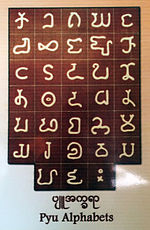speak a Sino-Tibetan language. The vast majority of these are the 1.3 billion native speakers of Sinitic languages. Other Sino-Tibetan languages with large...
87 KB (8,580 words) - 06:46, 3 October 2024
Proto-Sino-Tibetan (PST) is the hypothetical linguistic reconstruction of the Sino-Tibetan proto-language and the common ancestor of all languages in it...
20 KB (1,084 words) - 12:18, 1 July 2024
The Tibeto-Burman languages are the non-Sinitic members of the Sino-Tibetan language family, over 400 of which are spoken throughout the Southeast Asian...
40 KB (3,515 words) - 04:55, 18 September 2024
discredited language family proposal that includes widely-separated language groups spoken in the Northern Hemisphere: Sino-Tibetan languages, Yeniseian...
25 KB (2,658 words) - 06:19, 17 August 2024
The Pyu language (Pyu: ; Burmese: ပျူ ဘာသာ, IPA: [pjù bàðà]; also Tircul language) is an extinct Sino-Tibetan language that was mainly spoken in what is...
19 KB (1,656 words) - 01:21, 18 September 2024
The Tibetic languages form a well-defined group of languages descending from Old Tibetan (7th to 9th centuries, or to the 11th/12th centuries). According...
43 KB (3,724 words) - 02:02, 18 September 2024
Karenic languages are tonal languages spoken by some 4.5 million Karen people. They are of unclear affiliation within the Sino-Tibetan languages. The Karen...
13 KB (1,304 words) - 20:30, 8 July 2024
of the Garo dialect Sino-Tibetan (or Tibeto-Burman) language which is also related to Koch, Rabha, Bodo other than Garo language. It is spoken in the...
14 KB (1,604 words) - 13:32, 5 June 2024
Loloish languages, also known as Yi (like the Yi people) and occasionally Ngwi or Nisoic, are a family of fifty to a hundred Sino-Tibetan languages spoken...
11 KB (1,029 words) - 01:07, 29 July 2024
Austronesian languages are related to the Sinitic languages phonologically, lexically and morphologically. Sagart later accepted the Sino-Tibetan languages as a...
12 KB (1,040 words) - 01:45, 18 September 2024
languages, are a group of East Asian analytic languages that constitute a major branch of the Sino-Tibetan language family. It is frequently proposed that there...
63 KB (5,996 words) - 22:55, 8 September 2024
Naw[citation needed]) is a Sino-Tibetan language spoken by the Nung people in Fugong County, China, and Kachin State, Myanmar. The Anung language is closely related...
6 KB (394 words) - 20:06, 10 March 2024
historical linguists. A link between the Na–Dené languages and Sino-Tibetan languages, known as Sino–Dené had also been proposed by Edward Sapir. Around...
54 KB (5,077 words) - 13:46, 20 August 2024
The Gyalrongic languages (also known as Rgyalrongic or Jiarongic) constitute a branch of the Qiangic languages of Sino-Tibetan, but some propose that...
10 KB (1,002 words) - 16:29, 1 July 2024
named for the Tibetan ethnonym Bod, is a proposed grouping consisting of the Tibetic languages and associated Sino-Tibetan languages spoken in Tibet...
7 KB (692 words) - 21:32, 1 January 2024
the Sino-Tibetan family and is at odds with mainstream comparative linguistics, which firmly includes the Sinitic languages in the Sino-Tibetan family...
12 KB (1,232 words) - 19:29, 24 August 2024
predominantly located on the Tibetan plateau, almost all spoken languages of the country belong to the family of Sino-Tibetan languages, or more specifically...
16 KB (1,407 words) - 00:11, 18 September 2024
Chinese: 羌語支, "Qiang language group"; also Rmaic, formerly known as Dzorgaic) is a group of related languages within the Sino-Tibetan language family. They are...
18 KB (1,556 words) - 07:31, 3 September 2024
The Kiranti languages are a major family of Sino-Tibetan languages spoken in Nepal and India (notably Sikkim, Darjeeling, Kalimpong, and Bhutan) by the...
13 KB (1,211 words) - 23:18, 31 July 2024
Kuki-Chin languages (also called Kuki-Chin-Mizo, Kukish or South-Central Tibeto-Burman languages) are a branch of the Sino-Tibetan language family spoken...
15 KB (1,286 words) - 07:17, 28 September 2024
Classical Tibetan, especially when compared to the more conservative Amdo Tibetan. Like many languages, Lhasa Tibetan has a variety of language registers:...
52 KB (4,776 words) - 15:35, 14 September 2024
Tshangla is a Sino-Tibetan language of the Bodish branch closely related to the Tibetic languages. Tshangla is primarily spoken in Eastern Bhutan and...
23 KB (2,051 words) - 02:20, 21 August 2024
Tibeto-Burman languages and among the Sino-Tibetan languages, the second most widely spoken, after the Sinitic languages. Burmese was the fourth of the Sino-Tibetan...
10 KB (780 words) - 22:47, 11 September 2024
is the reconstructed ancestor of the Tibeto-Burman languages, that is, the Sino-Tibetan languages, except for Chinese. An initial reconstruction was produced...
46 KB (4,044 words) - 01:20, 18 September 2024
primarily in the state of Arunachal Pradesh and Assam. These languages belong to the Sino-Tibetan family and include several major dialects such as Nyishi...
15 KB (1,500 words) - 04:22, 4 August 2024
Arunachal languages are various languages in Arunachal Pradesh, India traditionally classified as Sino-Tibetan languages, but that may be language isolates...
3 KB (179 words) - 17:40, 5 January 2024
Sino-Tibetan or Chinese-Tibetan can refer to: Sino-Tibetan languages, a major language family of East and Southeast Asia, and of northern and northeastern...
588 bytes (101 words) - 16:51, 28 September 2022
Athabaskan–Eyak–Tlingit. A link between the Na–Dené languages and Sino-Tibetan languages, known as Sino–Dené was proposed by Edward Sapir. Around 1920 Sapir...
34 KB (3,252 words) - 07:57, 12 September 2024
languages, also called Bodic, Bodish–Himalayish, and Western Tibeto-Burman, are a proposed intermediate level of classification of the Sino-Tibetan languages...
6 KB (599 words) - 06:01, 19 August 2024
with Sino-Tibetan and Yeniseian with Burushaski (Karasuk hypothesis). A link between the Na–Dene languages and Sino-Tibetan languages, known as Sino-Dene...
38 KB (4,218 words) - 14:53, 2 September 2024















